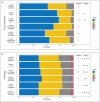Student Evaluation of a Learning Enhancement in Anatomy Program (LEAP) during the COVID-19 Pandemic: A Retrospective Study
- PMID: 39483179
- PMCID: PMC11522334
- DOI: 10.47895/amp.v57i10.7300
Student Evaluation of a Learning Enhancement in Anatomy Program (LEAP) during the COVID-19 Pandemic: A Retrospective Study
Abstract
Background and objective: The pandemic acted as an accelerator for the development of online teaching formats in anatomy and histology worldwide. The authors introduce a bridging program that reinforces the knowledge and understanding of gross and correlative anatomy and histology acquired in a virtual environment in preparation for its future clinical application. The study aims to evaluate the Learning Enhancement in Anatomy Program (LEAP) conducted among first-year medical students at the College of Medicine, University of the Philippines Manila.
Methods: This descriptive cross-sectional study aims to determine the initial experience of implementing a learning enhancement program and assess areas for its improvement. An internally validated questionnaire was given to students after the program to gauge students' reactions (Kirkpatrick Level 1 evaluation). Pre- and post-tests were administered to evaluate knowledge acquisition (Kirkpatrick Level 2 evaluation). Short-term behavioral peer evaluation (Kirkpatrick Level 3 evaluation) was also instituted.
Results: One hundred fifty-two (152) students participated in the study. General reactions from students to the LEAP were consistently positive, with a steady majority of the students rating '5' or a 'Strongly Agree' to positive statements regarding the program. Higher ratings for more traditional teaching methods, such as cadavers, formalinized specimens, and bones, compared to virtual systems were apparent. However, inter-student variation in preference for teaching modalities was observed. All stations of the LEAP were evaluated satisfactorily, with most gross anatomy stations rated higher than histology stations. A significant increase was noted in the total post-test scores compared to pre-test scores. This improvement in test scores was observed in the anatomy and histology subcategories and in six of the seven organ system modules. Perceived behavioral outcomes were also generally positive.
Conclusion: The LEAP is a worthwhile endeavor, garnering overwhelmingly positive reactions and a significant improvement in test scores. Future studies are necessary to fine-tune teaching and training in a blended learning environment.
Keywords: COVID-19; anatomy; medical education; program evaluation.
© 2023 Acta Medica Philippina.
Conflict of interest statement
All authors declared no conflicts of interest.
Figures





References
LinkOut - more resources
Full Text Sources
